
In my last column here on Search Engine Land, I shared tips and tricks I’ve learned over the years in regard to link prospecting.
One process for finding link opportunities that I didn’t cover is competitor backlink analysis.
Competitor analysis is fundamental to creating a link-building campaign. You’ll learn which tactics are securing links for the competition, which pages are driving search traffic, anchor text distribution, the competitive landscape and more.
Solid competitive analysis provides:
- niche insight: linking environment, competitive landscape, potential link opportunities;
- competitor tactics: sponsorships/partnerships, blogger outreach, affiliate marketing, guest posting and so on; and
- content analysis: competitor strategies, popular topics and formats, content gaps.
In this post, I’ll walk through competitor analysis, using a running example to highlight the important information you can learn by checking your competitors’ backlinks, keywords and content.
My example for this post will be 1Up Box, a monthly subscription box that delivers “epic gear for geeks and gamers.” I fancy myself a bit of a geek/gamer, and I’ve definitely toyed with the idea of purchasing 1Up Box. They are, of course, not a client.
Identifying search competitors

Identifying search competitors is the first step in a competitive analysis. There are a few different ways to unearth search competitors. I recommend:
- talking to your client (they know the most about their business);
- checking important SERPs;
- SEMrush
- BuzzSumo
Using the tools and methods listed above, I’ve identified 1Up Box’s top search competitors:
- Loot Crate
- Nerd Block
- Geek Fuel
- Geek Me Box
Finding and identifying search competitors is the easy part, so let’s focus mostly on analysis.
Niche insight: reviewing how 1Up Box measures against the competition
If your goal is to secure links, you need to understand the linking environment within your niche.
The first insight of a competitor analysis is how competitive your client is in in search. Backlink tools like Majestic and Open Site Explorer will help you determine this information.
For 1Up Box, I’ll examine their top competitors in Majestic.
Loot Crate:

Nerd Block:

Geek Fuel:

And Geek Me Box:

Loot Crate has a substantially larger backlink profile than the other three, which is likely due to the competitive advantage Loot Crate enjoys from being the first major geek subscription box service to market. Loot Crate was founded in 2012 vs. 2013 (Nerd Block) and 2014 (Geek Fuel).
Comparing these numbers to 1Up Box’s referring domains shows that 1Up Box is lagging behind (except for Geek Me Box):

1Up Box is a major underdog compared to Loot Crate in terms of links and organic search. In fact, I can use SEMrush to quickly assess how 1Up Box measures up to these competitors in terms of average monthly organic traffic. SEMrush reports the following data for estimated monthly organic search traffic:
- 1Up Box — 814
- Loot Crate — 371,000
- Nerd Block — 9,400
- Geek Fuel — 1,000
- Geek Me Box — 180
Note: SEMrush traffic numbers are not exact and do not represent exact data. These numbers are estimates.
Loot Crate is the clear winner in search traffic, dominating the search market. I would immediately communicate this to 1Up Box to set expectations. It would take a strategic, sustained campaign to cultivate a link profile that could compete with Loot Crate, Nerd Block and Geek Fuel. (1Up Box is outperforming Geek Me Box in both links and organic search traffic, however.)
The good news is the linking environment of the subscription box niche is fairly open and unrestricted, based upon the number of links these competitors have.
Reviewing search traffic, keywords and pages with SEMrush
Competitive analysis should also focus on competitor strategies and tactics.
You don’t want to blindly copy your competitors, but if they’re securing links that are relevant to your site, you should consider implementing similar tactics in your own campaign.
A good method to uncover competitor tactics is to examine which keywords and pages drive organic traffic using SEMrush. Here are the top keywords bringing Loot Crate traffic:

[Click to enlarge.]
The top four non-branded keywords are:
- “anime”
- “call of duty”
- “fallout 4”
- “black ops 3”
Loot Crate created specific themed crates around each of these terms, and each theme has a dedicated landing page. For example:

These dedicated pages allow Loot Crate to tap into a different search market, expanding their reach beyond the smaller subscription box market.
SEMrush reveals a similar situation for Nerd Block, with the majority of their traffic coming from themes around “arcade” and “horror”:
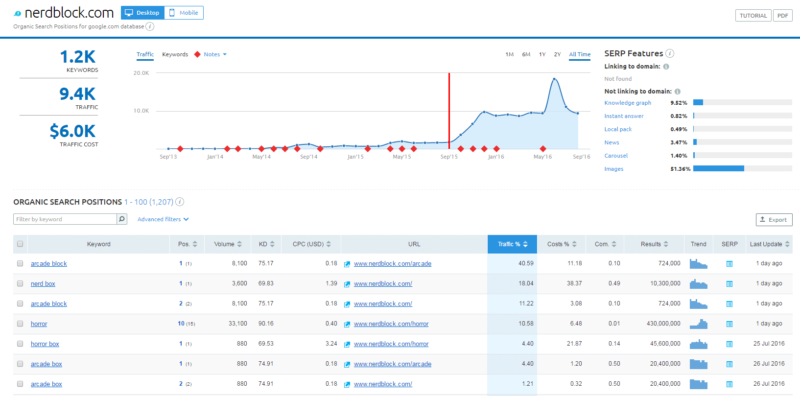
[Click to enlarge.]
Like Loot Crate, Nerd Block has also created dedicated landing pages targeting these terms:

Both Loot Crate and Nerd Block are capturing a significant amount of their organic traffic by executing the same strategy: creating strategic pages for their boxes based on popular themes.
1Up Box does not have any dedicated pages to themed boxes. 1Up Box does have a “Past Boxes” page, but it isn’t specific and instead features an image slider that scrolls through a few of their past boxes:

1Up Box also doesn’t provide the option to purchase past boxes. I’d suggest that 1Up Box consider keeping their most popular boxes available for purchase, as it would provide an enticing entry point for new customers. I would also advise 1Up Box to build dedicated pages for these boxes.
I’d also encourage the folks at 1Up Box to create targeted themes moving forward to tap into a specific audience. For example, a Nintendo-themed box could target keywords and phrases related to Nintendo and thus capture new traffic.
Even if 1Up Box isn’t capable of implementing dedicated pages and themed boxes now, they should know that Loot Crate and Nerd Block are securing a market advantage with this strategy.
Competitor backlink analysis with Majestic
The next step in a competitor analysis is digging into the backlinks themselves — which means using Majestic (or your preferred backlink explorer).
Analyzing backlink data can also help unearth competitor strategies.

After digging through the first couple pages of Loot Crate’s backlinks to understand their link profile, I notice a common theme. Loot Crate is earning a healthy number of links through sponsorships — particularly through sponsoring podcasts like this:

Or this:
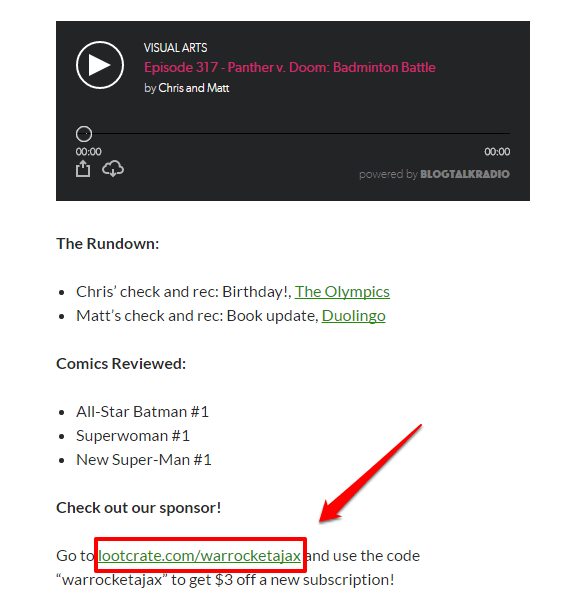
Along with sponsorships, Loot Crate has also partnered with 343 Industries (makers of Halo) to get a link on Microsoft’s Xbox news site:

Sponsorships and partnerships are an integral part of Loot Crate’s online strategy. They’ve built numerous partnerships that have benefited their marketing and link profile. These links are powering their dedicated crate landing pages, allowing them to rank well in search for high-volume terms. This is another key strategy (partnerships) I would highlight for 1Up Box.
I’ll also look at the backlinks for Geek Me Box, because they are on the opposite side of the competitive spectrum (in terms of links).
A common theme I’m noticing among Geek Me Box’s links is that many of them come from blogger coverage. This includes both affiliate links…
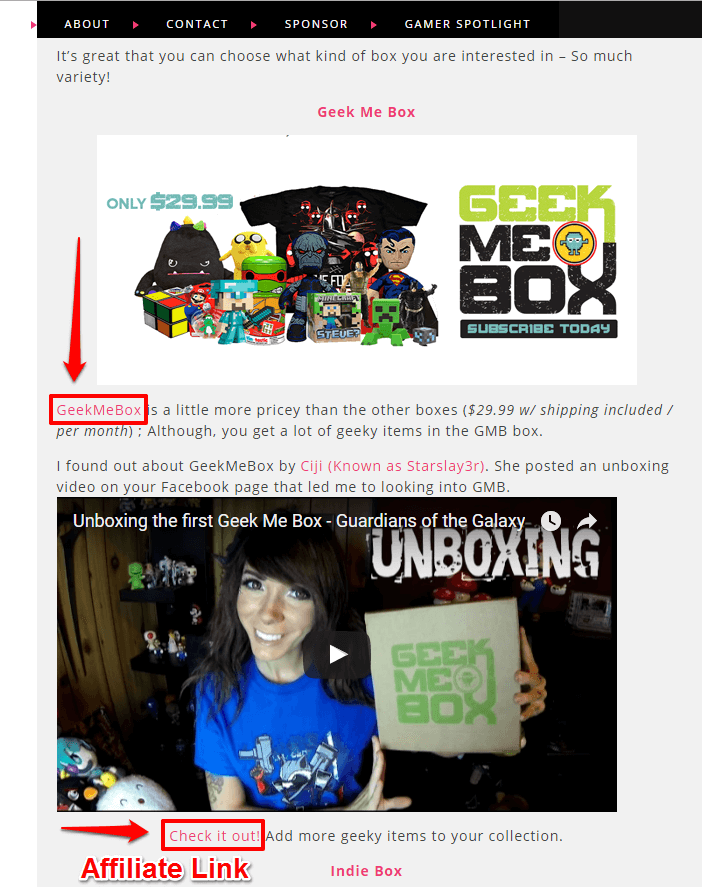
… and coverage from bloggers who are not affiliated with the company:
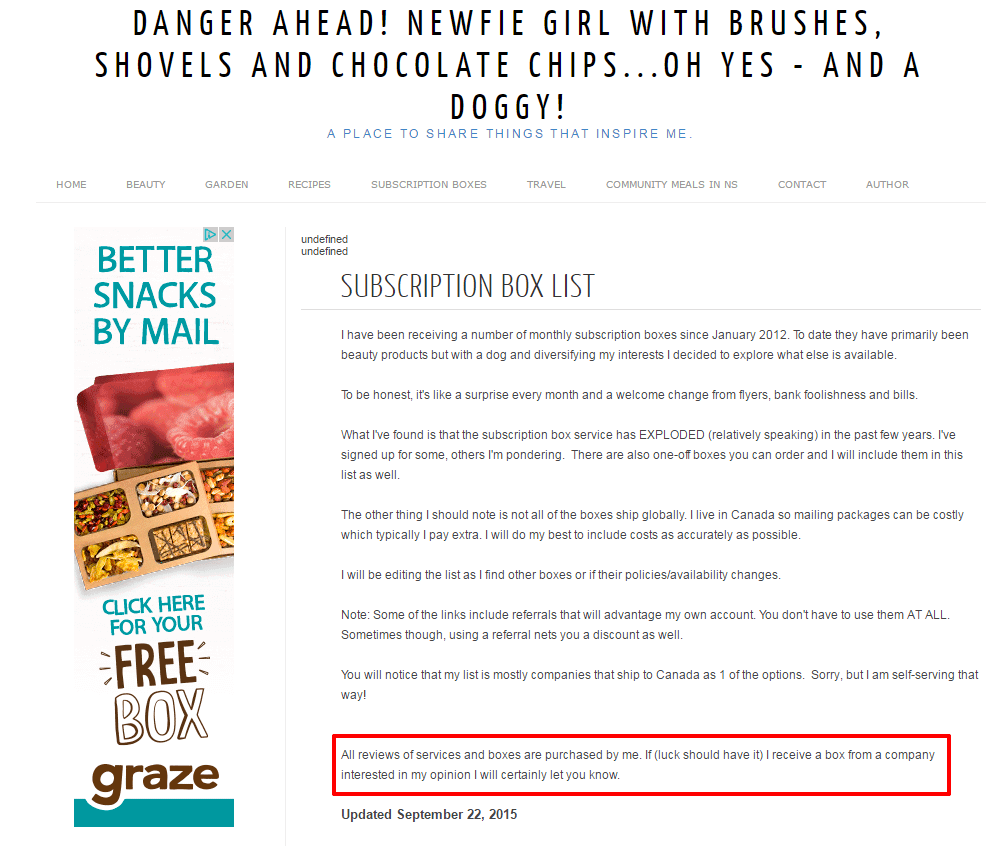
Even the unaffiliated blogger still links to Geek Me Box in this case:

Note: Use of blogger coverage should be done sparingly, as part of a diverse strategy.
Judging from Geek Me Box’s backlink profile, this isn’t the most fruitful approach. While I may not immediately pursue this tactic for 1Up Box, it’s worth noting that it’s a strategy 1Up Box’s competition is executing.
In performing my competitor backlink analysis for Geek Me Box, I actually found this blogger coverage, which includes an unlinked mention of 1Up Box!

There is a chance this blogger would be open to mentioning 1Up Box on this review page, assuming this isn’t a paid review. After all, it makes sense for their audience. And as a bonus, this review also reveals a USP and competitive advantage for 1Up Box: They’re more affordable than the competition.
Content analysis with BuzzSumo
Content analysis is an important piece of any competitive analysis. You should take a moment to understand what content is available and popular with your audience.
To discover these topics, you need to analyze your competitors’ content and find which articles, infographics, videos and so on have been most popular. A great place to start is on your competitors’ blogs.
For 1Up Box, I’m going to take a gander at both the Geek Fuel blog and The Daily Crate (Loot Crate). They appear to be the only two competitors that have active blogs.
One of my favorite tools for content analysis is BuzzSumo. To analyze content, I put The Daily Crate’s domain into BuzzSumo:
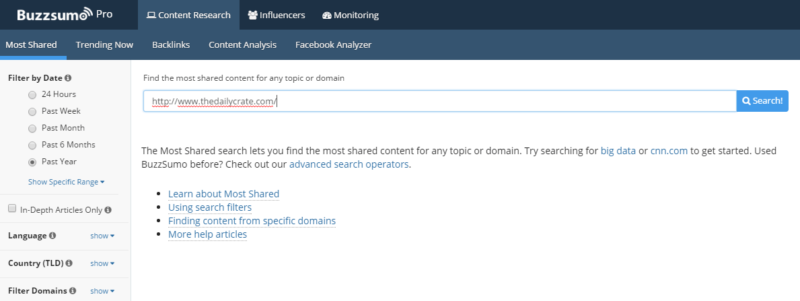
BuzzSumo will return the top content (ranked by number of social shares) on Loot Crate’s blog. I quickly notice the content on The Daily Crate isn’t shared by a large audience:

[Click to enlarge.]
Using the same process with BuzzSumo, I find a similar situation with Geek Fuel’s blog and content:

[Click to enlarge.]
It appears that neither Loot Crate nor Geek Fuel has been able to build a large audience with its blogs.
While 1Up Box doesn’t have a blog (and they might not have any interest in producing content), I would notify them that the opportunity exists. There is a dearth of popular content within 1Up Box’s niche, and they have a chance to be the first to market here and build a community. It would require an investment of time and resources, but a strategic content initiative could win 1Up Box a share of the greater audience.
Strategy recap
Analysis of 1Up Box’s competitors has provided valuable insight and will inform strategy development to help 1Up Box succeed in search.
To recap:
- Themed boxes with dedicated pages. Both Loot Crate and Nerd Block are capturing a significant amount of organic traffic by creating dedicated pages for boxes based on popular themes — a strategy 1Up Box should absolutely consider.
- Sponsorship/partnership opportunities. Sponsorships and partnerships are an integral (and effective) component of Loot Crate’s online marketing, and something 1Up Box should consider for their own strategy.
- Relationship building. Geek Me Box has done an excellent job building relationships with bloggers and earning coverage and links; this tactic could be fruitful for 1Up Box as well.
- Content creation and community building. None of 1Up Box’s top competitors have been successful in building a substantial blog following or community, which represents a real opportunity for 1Up Box to seize market share and grow site traffic.
Competitive analysis reveals a wealth of important information that can guide strategy development. If you’re a link builder (like me) your primary focus is securing links, and that means finding link opportunities.
Link opportunities
Based on the findings from my competitive backlink analysis above, here is a list of link opportunities that I could pursue for 1Up Box today.
Note: I would not necessarily pursue all these opportunities, but rather I’m demonstrating what’s possible with competitive analysis. Also, this is by no means an exhaustive list. There are further opportunities available to 1Up Box.
Tactic: Backlink profile exploration and analysis:
Opportunity: This is a short list of some of the sites that are linking to Nerd Block. Because Nerd Block is a competitor with a shared audience, many of the sites linking to Nerd Block also represent promising link opportunities for 1Up Box.
Tactic: Monitoring competitor mentions via BuzzSumo or Fresh Web Explorer:
Opportunity: These are all sites that have mentioned 1Up Box’s competitor, Geek Fuel, indicating potential relevance and link opportunities.
The post Search competitor analysis: backlinks, keywords and pages appeared first on Search Engine Land.
